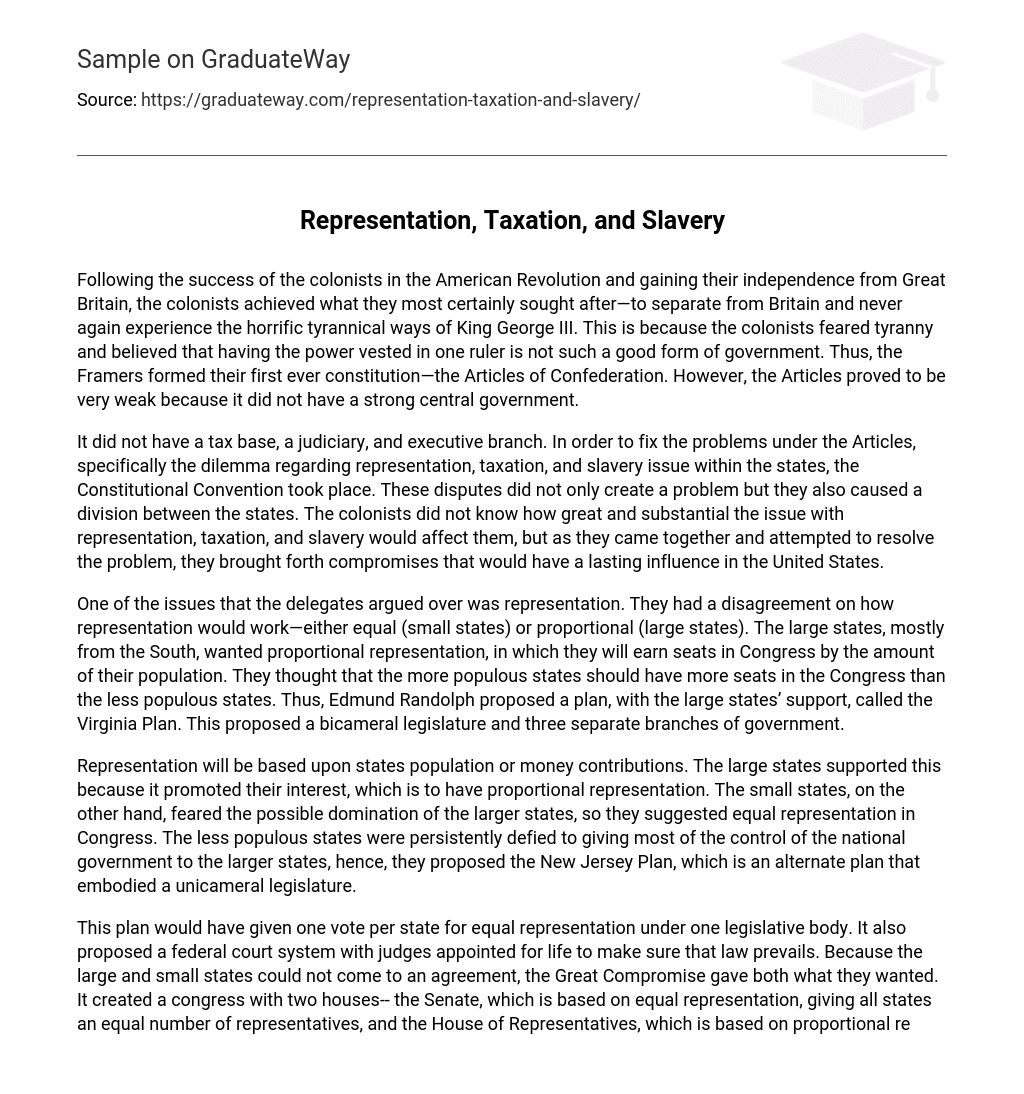Following the American Revolution, the colonists achieved independence from Great Britain and escaped King George III’s oppressive rule. They were apprehensive about tyranny and opposed a government structure that centralized authority in one leader. Consequently, in an effort to address this concern, the Framers drafted the Articles of Confederation as their first constitution. Regrettably, these Articles proved ineffective due to their absence of a robust central government.
The Articles of Confederation had several issues, including a lack of tax base, judiciary, and executive branch. To address these problems, the Constitutional Convention was held. The purpose of this convention was to resolve disputes regarding representation, taxation, and slavery among the states. These disagreements not only caused divisions between the states but also had significant ramifications for the colonists. Through collaborative efforts to find solutions, compromises were reached that would have a lasting impact on the United States.
The topic of representation was discussed by the delegates, who deliberated whether it should be equal or proportional. Representatives from the South’s larger states defended proportional representation, advocating for seats in Congress to be based on population. They held the belief that states with a greater population should have a larger number of seats compared to those with a smaller population. Consequently, Edmund Randolph presented the Virginia Plan, which received support from the large states. This proposal recommended a legislature consisting of two chambers and three distinct branches of government.
During the formation of the United States, there was a dispute regarding representation in the national government. The disagreement centered on whether representation should be determined by a state’s population or its financial contributions. Larger states favored population-based representation to align with their desire for proportional representation. Conversely, smaller states worried about being overshadowed and pushed for equal representation in Congress. To reconcile this division, the New Jersey Plan was put forth as an alternative to the Virginia Plan. This proposal suggested establishing a unicameral legislature that would grant less populous states equitable control in the national government.
The purpose of this plan was to achieve fair representation for every state in a single legislative body. It also proposed the creation of a federal court system with judges serving lifelong terms to ensure the enforcement of laws. Due to the inability of larger and smaller states to agree, the Great Compromise presented a solution that satisfied both sides. It established a two-house congress: the Senate, which granted equal representation by assigning each state an equal number of representatives, and the House of Representatives, which achieved proportional representation by electing representatives based on population.
Under the Articles of Confederation, Congress did not have the power to declare or collect taxes, resulting in a situation where the government would incur debt without being able to gather taxes. This taxation issue caused a disagreement between the Northern and Southern colonies. The Northern colonies supported a strong central government and a nationwide tax applicable to all states.
One reason for the desire to unite the nation and gain control over trade, resolve conflicts, and establish leadership was the Southern states’ preference for a strong state government with limited taxes confined to their own states. They were worried that a national tax could result in an overly centralized government similar to a monarchy and oppressive rule returning. Their goal was to eliminate the central government due to concerns about potential power abuses, asserting that states should have authority over governance and taxation rather than relying on the federal government.
During the Constitutional Convention, proposals were presented to address a dilemma that had arisen. As a result, Congress was granted the authority to levy taxes, as stated in Article I, Section 8 of the Constitution. One prominent challenge faced by the states during this time revolved around slavery.
Differing opinions arose regarding whether slaves should be included in population counts for representation and taxation purposes. The Northern states opposed including slaves in population counts for representation but supported their inclusion for taxation. On the other hand, Southern states advocated for counting slaves in Congress but not including them in taxation.
The reason for wanting slaves to be counted for representation was to increase power and gain more seats in Congress. To resolve the dispute about representation and taxation related to slaves, a compromise was reached during the Constitutional Convention. This compromise stated that three-fifths of the slave population would be counted for both representation and taxes. While this compromise settled the issue of representation and taxation, the question of whether to abolish or keep slavery remained a contentious problem between the Northern and Southern states, which required further deliberation to find a solution.
The Northern colonies opposed slavery and supported its abolition because they believed it was morally wrong. In contrast, the South depended on slavery for survival as it played a crucial role in maintaining their economic stability. The slaves served as a lifeline for the South, providing unpaid labor that was essential for cultivating their fields. Removing this labor would have devastating financial consequences for the South. Therefore, it is important to consider the financial impact of ending slavery in the region.
The economic viability of the Southern colonies depended on slavery, rather than its ethical implications. However, this unresolved issue ultimately led to the Civil War, a five-year-long and highly deadly conflict in America between 1860 and 1865. Slavery played a crucial role in sparking this war. Despite Abraham Lincoln’s issuance of the Emancipation Proclamation in 1863, which did result in a decrease and eventual elimination of slavery, it was not until the Thirteenth Amendment that an official declaration was made deeming slavery unconstitutional.
Despite failing to achieve its initial goal of revising the Articles, the Constitutional Convention eventually resulted in the creation of the United States Constitution. This important document effectively resolved long-standing and problematic issues related to representation, taxation, and slavery. Although addressing these matters required significant time and effort, their influence is still evident today.





